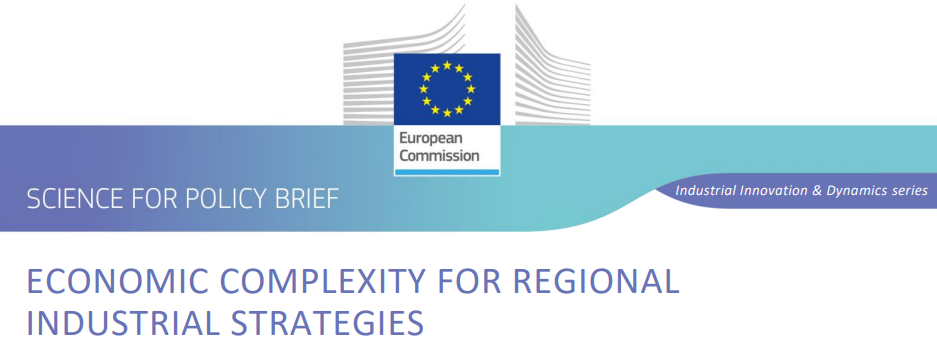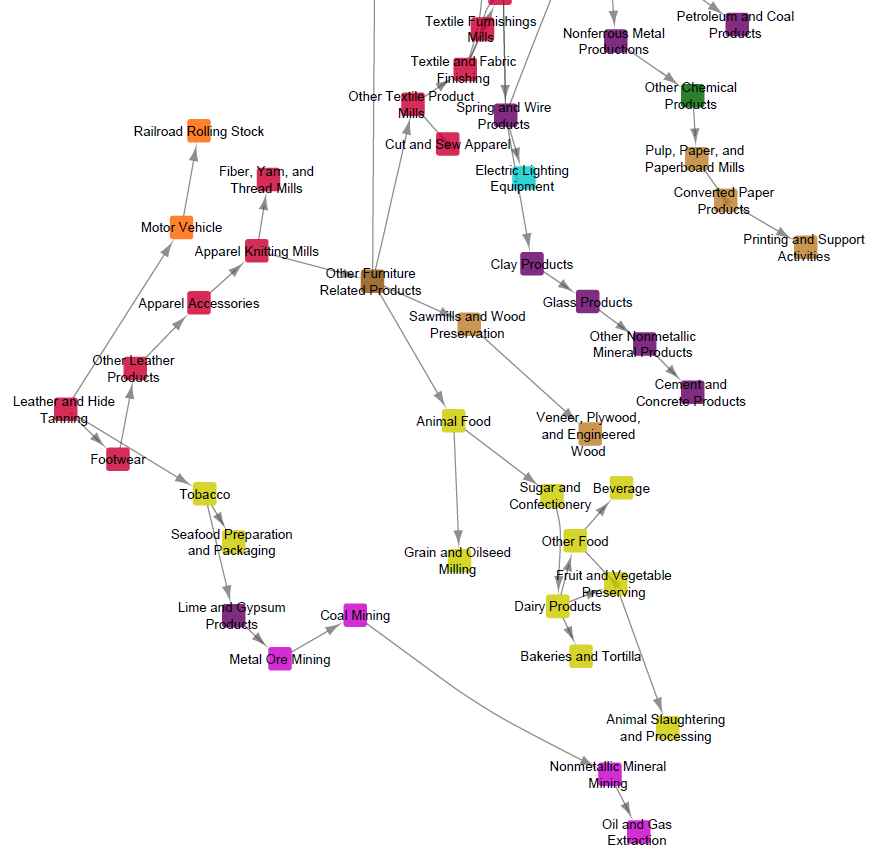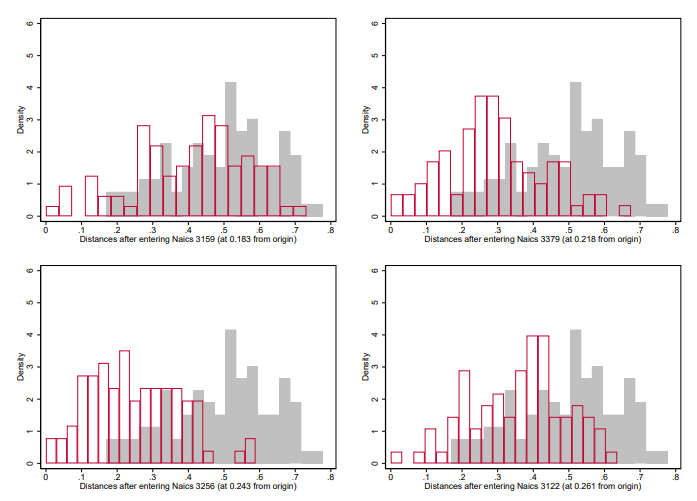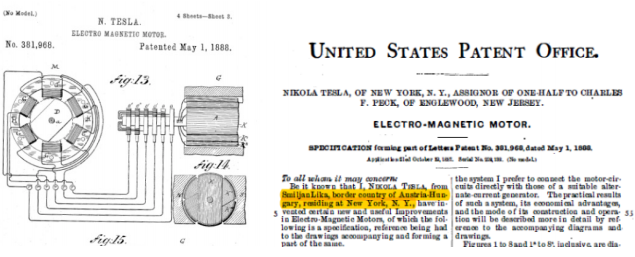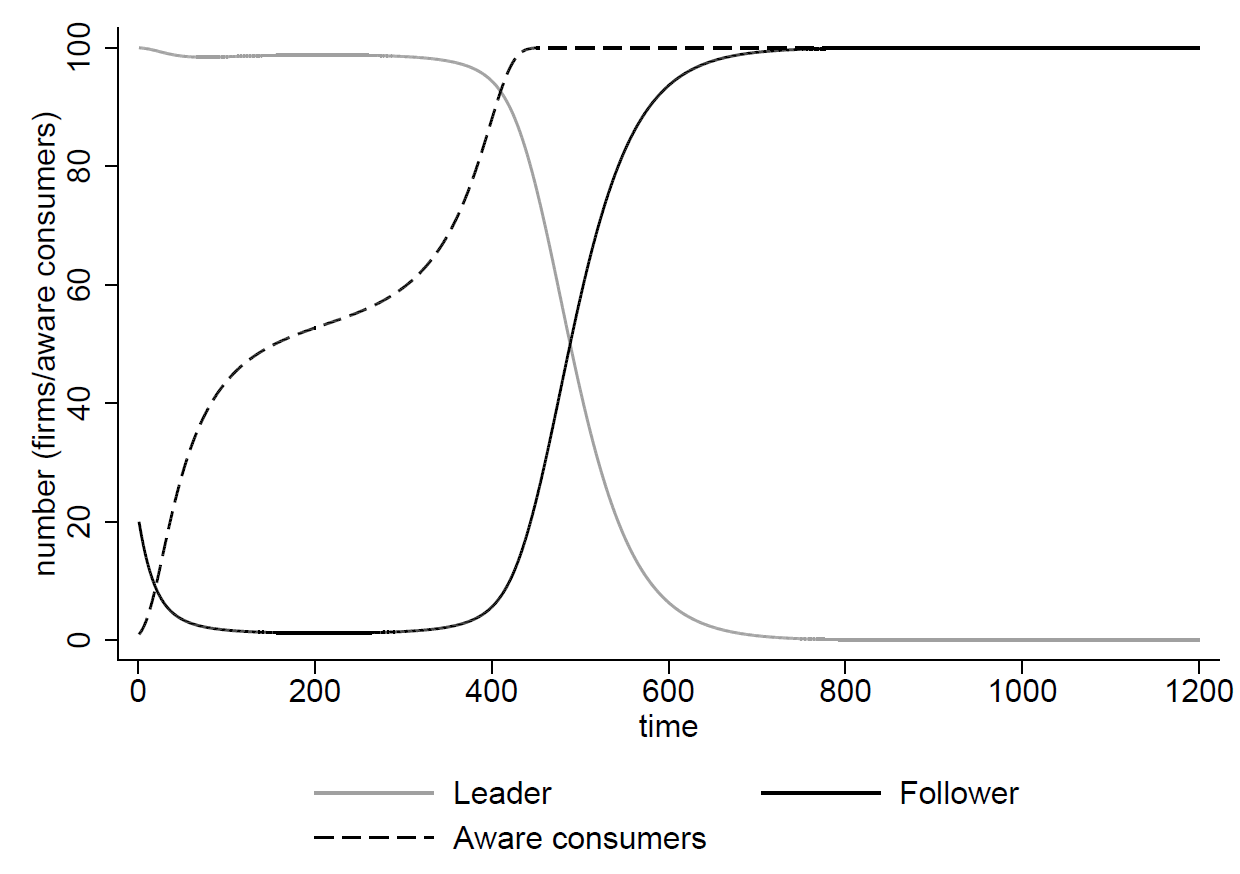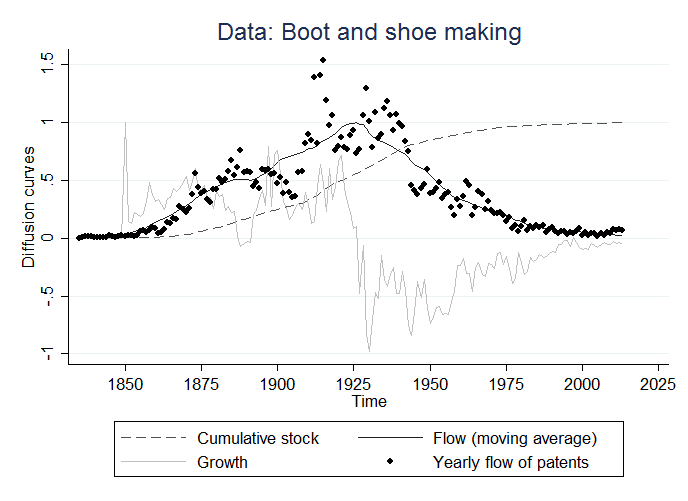Dario Diodato, Lorenzo Napolitano, Emanuele Pugliese, Andrea Tacchella (2023), . Publications Office of the European Union Agency
Constructing a genotypic product space
Ulrich Schetter, Dario Diodato, Eric Protzer, Frank Neffke, Ricardo Hausmann (2024); Papers in Evolutionary Economic Geography #24.19
Economic complexity analysis has shown that one can predict the diversification of countries (or regions) into new activities. This is thanks to an empirical tool known as the product space, which infers the similarity of activities from output patterns. While these methods are underpinned by a theory of capabilities, economic complexity is grounded in outcome-based metrics and remains — using a metaphor from biology — phenotypic in nature. In this paper we show how to conduct economic complexity analysis directly on capabilities, by interpreting input requirements of industries as genetic code. We exploit our framework to empirically (i) build a genotypic product space, (ii) to infer countries’ capabilities, and (iii) measure the capabilities that a country is missing for diversifying into a given industry. We then discuss the many advantages of this framework in terms of understanding the development process and of designing policies.
The impact of return migration on employment and wages in Mexican cities
Dario Diodato, Ricardo Hausmann, and Frank Neffke (2023), Journal of Urban Economics Vol.135
How does return migration from the US to Mexico affect local workers? Return migrants increase the local labor supply, potentially hurting local workers. However, having been exposed to a more advanced U.S. economy, they may also carry human capital that benefits non-migrants. Using an instrument based on involuntary return migration, we find that, whereas workers who share returnees’ occupations experience a fall in wages, workers in other occupations see their wages rise. These effects are, however, transitory and restricted to the city-industry receiving the returnees. In contrast, returnees permanently alter a city’s long-run industrial composition, by raising employment levels in the local industries that hire them.
A simple theory of economic development at the extensive industry margin
Dario Diodato, Ricardo Hausmann, Ulrich Schetter (2022), CID Faculty Working Paper No.416 – R&R at the Journal of the European Economic Association (JEEA)
We revisit the well-known fact that richer countries tend to produce a larger variety of goods and analyze economic development through (export) diversification. We show that countries are more likely to enter ‘nearby’ industries, i.e., industries that require fewer new occupations. To rationalize this finding, we develop a small open economy (SOE) model of economic development at the extensive industry margin. In our model, industries differ in their input requirements of non-tradeable occupations or tasks. The SOE grows if profit maximizing firms decide to enter new, more advanced industries, which requires training workers in all occupations that are new to the economy. As a consequence, the SOE is more likely to enter nearby industries in line with our motivating fact. We provide indirect evidence in support of our main mechanism and then discuss implications: We show that there may be multiple equilibria along the development path, with some equilibria leading on a pathway to prosperity while others resulting in an income trap, and discuss implications for industrial policy. We finally show that the rise of China has a non-monotonic effect on the growth prospects of other developing countries, and provide suggestive evidence for this theoretical prediction.
Eight decades of changes in occupational tasks, computerization and the gender pay gap
Ljubica Nedelkoska, Shreyas Gadgin Matha, James McNerney, Andre Assumpcao, Dario Diodato, Frank Neffke (2021), Unpublished draft – Druid 2023 Best Paper Award
We build a new longitudinal dataset of job tasks and technologies by transforming the US Dictionary of Occupational Titles (DOT, 1939-1991) and four books documenting occupational use of tools and technologies in the 1940s, into a database akin to, and comparable with its digital successor, the O* NET (1998-today). After creating a single occupational classification stretching between 1939 and 2019, we connect all DOT waves and the decennial O* NET databases into a single dataset, and we connect these with the US Decennial Census data at the level of 585 occupational groups. We use the new dataset to study how technology changed the gender pay gap in the United States since the 1940s. We find that computerization had two counteracting effects on the pay gap-it simultaneously reduced it by attracting more women into better-paying occupations, and increased it through higher returns to computer use among men. The first effect closed the pay gap by 3.3 pp, but the second increased it by 5.8 pp, leading to a net widening of the pay gap.
The new paradigm of economic complexity
Pierre-Alexandre Balland, Tom Broekel, Dario Diodato, Elisa Giuliani, Ricardo Hausmann, Neave O’Clery, and David Rigby (2022), Research Policy Vol.51(3)
Economic complexity offers a potentially powerful paradigm to understand key societal issues and challenges of our time. The underlying idea is that growth, development, technological change, income inequality, spatial disparities, and resilience are the visible outcomes of hidden systemic interactions. The study of economic complexity seeks to understand the structure of these interactions and how they shape various socioeconomic processes. This emerging field relies heavily on big data and machine learning techniques. This brief introduction to economic complexity has three aims. The first is to summarize key theoretical foundations and principles of economic complexity. The second is to briefly review the tools and metrics developed in the economic complexity literature that exploit information encoded in the structure of the economy to find new empirical patterns. The final aim is to highlight the insights from economic complexity to improve prediction and political decision-making. Institutions including the World Bank, the European Commission, the World Economic Forum, the OECD, and a range of national and regional organizations have begun to embrace the principles of economic complexity and its analytical framework. We discuss policy implications of this field, in particular the usefulness of building recommendation systems for major public investment decisions in a complex world.
Identifying labour market bottlenecks in the energy transition: a combined IO-matching analysis
Maureen Lankhuizen, Dario Diodato, Anet Weterings, Olga Ivanova and Mark Thissen (2022), Economic Systems Research
This paper combines an input–output model and a novel regional labour market matching model in order to identify potential bottlenecks in regional labour markets resulting from shocks in demand caused by the energy transition. Identifying these bottlenecks provides relevant information for policymakers to determine in which regions and industries policy intervention in labour markets may be needed to ensure a smooth transformation. We analyse the effects of a shock that is illustrative for the energy transition in the Netherlands. Our results indicate that the aim of the Dutch government to substantially reduce greenhouse gas emissions may, at least in the short run, be hampered by bottlenecks in labour markets.
Migration and invention in the age of mass migration
Andrea Morrison, Sergio Petralia, and Dario Diodato (2022), Journal of Economic Geography Vol.22(2)
More than 30 million people migrated to the USA between late-ninetieth and early-twentieth century, and thousands became inventors. Drawing on a novel dataset of immigrant inventors in the USA, we assess the city-level impact of immigrants’ patenting and their contribution to the technological specialization of the receiving US regions between 1870 and 1940. Our results show that native inventors benefited from the inventive activity of immigrants. In addition, we show that the knowledge transferred by immigrants gave rise to new and previously not exiting technological fields in the US regions where immigrants moved to.
Why do industries coagglomerate? How Marshallian externalities differ by industry and have evolved over time
Dario Diodato, Frank Neffke, and Neave O’Clery (2018), Journal of Urban Economics Vol.106. 1-26.
The fact that firms benefit from close proximity to other firms with which they can exchange inputs, skilled labor or know-how helps explain why many industrial clusters are so successful. Studying the evolution of coagglomeration patterns, we show that the type of agglomeration that benefits firms has drastically changed over the course of a century and differs markedly across industries. Whereas, at the beginning of the twentieth century, industries tended to colocate with their value chain partners, in more recent decades the importance of this channel has declined and colocation seems to be driven more by similarities in industries’ skill requirements. By calculating industry-specific Marshallian agglomeration forces, we are able to show that, today, skill-sharing is the most salient motive behind the location choices of services, whereas value chain linkages still explain much of the colocation patterns in manufacturing. Moreover, the estimated degrees to which labor and input-output linkages are reflected in an industry’s coagglomeration patterns help improve predictions of city-industry employment growth.
The made-in effect and leapfrogging: A model of leadership change for products with country-of-origin bias
Dario Diodato, Franco Malerba, and Andrea Morrison (2018), European Economic Review Vol.101. 297-329.
Change in industrial leadership is often explained in terms of technological and costs advantages. However firms in emerging economies not only have to produce high quality, cost-competitive goods, but also win the resistance of consumers in the world market, who are often adverse to purchasing products from countries that yet have to build a reputation. We argue that this country-of-origin bias significantly influences the chances of leadership change.
A model that aims at capturing the endogenous dynamics of demand building and leapfrogging is proposed. We show that in sectors with high monopoly power acquiring a superior technology is not sufficient for a latecomer country to become leader, unless a significant share of consumers is aware of the quality of its products. An extension of the model to multiple sectors shows that a latecomer country remains specialized into low-value undifferentiated goods, even after overtaking the technology of the leading country.
The resilience of regional labour markets to economic shocks: Exploring the role of interactions among firms and workers
Dario Diodato and Anet Weterings (2015), Journal of Economic Geography Vol.15-4. 723-742.
To date, theoretical and empirical insights in the determinants of regional resilience are still limited. Using a model, we explore how three regional factors jointly contribute to the resilience of regional labour markets to economic shocks. The localization of the supply network (1) is used to model the propagation of the shock, while possibilities for intersectoral (2) and interregional labour mobility (3) to analyse the recovery. An application of the model to Dutch data suggests that labour markets in centrally located and service-oriented regions have, on average, a higher recovery speed, irrespective of the type of shock hitting the economy.
The magnitude and distance decay for trade in goods and services: New evidence for European countries
Martijn Burger, Mark Thissen, Frank van Oort, and Dario Diodato (2014), Spatial Economic Analysis Vol.9-3. 231-259.
Using a newly assembled, consistent and disaggregated dataset (12 goods and 7 services) on internal and bilateral trade for 25 European countries, we analyse the difference between trade in goods and services. The measurement of both trade in goods and trade in services is improved over earlier research, allowing us to compare trade in goods and services in a coherent and systematic way. First, our dataset is made consistent with the domestic demand and production and the total exports and imports at the sector and product levels. Second, we explicitly control for re-exports. We find that, although goods are more often bilaterally traded than services, the volume of bilateral trade in services does not attenuate less with distance than the volume of bilateral trade in goods.
The impact
Dario Diodato, Ricardo Hausmann, and Frank Neffke (2020), Papers in Evolutionary Economic Geography n.20.12
We study the effect of return migration from the U.S. to Mexico on the economies of Mexican cities. In principle, returnees increase the local labor supply and therefore put pressure on wages and employment rates of locals. However, having worked in the technologically more advanced US economy, they may also possess skills that complement the skills of local workers or even bring in new organizational and technological know-how that leads to productivity improvements in Mexico. Using an instrument based on involuntary return migration due to deportation by US authorities, we find evidence in support of both effects. Returnees affect wages of locals in different ways: whereas workers who share the returnees’ occupations experience a fall in wages, workers in other occupations see their wages rise. However, the latter, positive, effect is easily overlooked, because it is highly localized: it only affects coworkers within the same city-industry cell. Moreover, both, positive and negative, wage effects are transitory and eventually disappear. In contrast, by raising the employment levels of the industry in which they find jobs, returnees permanently alter a city’s industry composition.
Structural accounting: An empirical assessment of cross-country differences in productivity
Dario Diodato (2020), Papers in Evolutionary Economic Geography n.20.20
This paper proposes a method to decompose cross-country differences in productivity (TFP) into a technological component – depending on the overall productivity of a country – and an allocation component, which depends on whether factors of productions are allocated to productive or unproductive industries. Using a sample of over 2 million firms from 30 countries, the analysis estimates that 1/4 of inequality between countries is due to the Composition effect, while 3/4 to the Place effect. Moreover, once accounting for heterogeneity at the subnational level, I find that the Composition effect may be as high as 50%.
Technological regimes and the geography of innovation: a long-run perspective on US inventions
Dario Diodato and Andrea Morrison (2019), Papers in Evolutionary Economic Geography n.19.24
The geographical distribution of innovative activities is an emerging subject, but still poorly understood. While previous efforts highlighted that different technologies exhibit different spatial patterns, in this paper we analyse the geography of innovation in the very long run. Using a US patent dataset geocoded for the years 1836-2010, we observe that – while it is true that differences in technologies are strong determinant of spatial patterns – changes within a technology over time is at least as important. In particular, we find that regional entry follows the technology life cycle. Subsequently, innovation becomes less geographical concentrated in the first half of the life cycle, to then re-concentrate in the second half.

